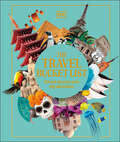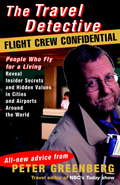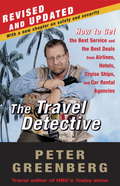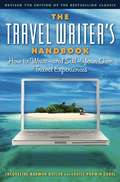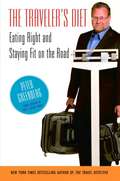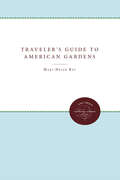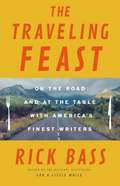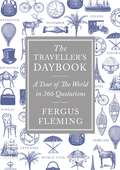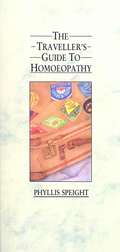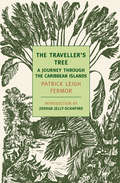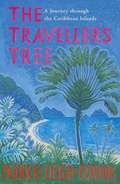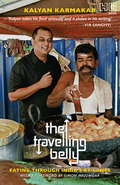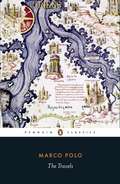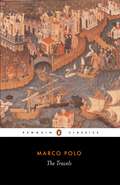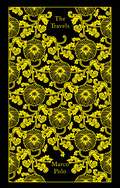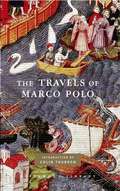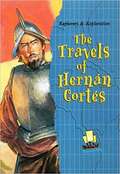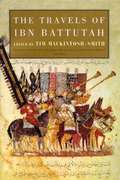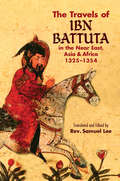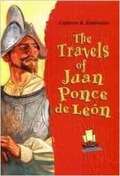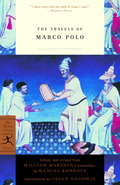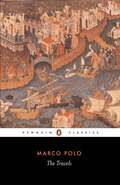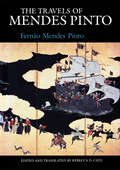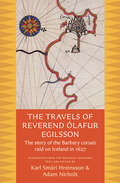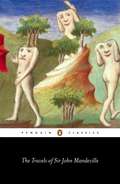- Table View
- List View
The Travel Bucket List
by DK TravelCounting down the 500 experiences every traveller should have in a lifetime, this is the travel list to end all travel lists.And trust us, we know. At DK Eyewitness, we've helped travellers get closer to destinations around the world for over 40 years. We've celebrated the world's most unforgettable journeys, showed people where to go when, and shone a light on the must-see and top ten sights to see on the road. Now, we've made one book to top them all, the ultimate bucket list.For trips of a lifetime, look no further. Here you'll find the ancient sights and modern marvels that no traveller should miss. The natural wonders and wildlife watching adventures that dreams are made of. And the little, local experiences that remind us why we travel in the first place.Expect beautiful photography, handy maps and tips to help you make your bucket list dreams happen. DK Eyewitness’s The Definitive Travel Bucket List has everything you need to make a lifetime of memories. You’ll have it on your bookshelf for years to come.
The Travel Detective Flight Crew Confidential: People Who Fly for a Living Reveal Insider Secrets and Hidden Values in Cities and Airports Around the World
by Peter GreenbergThe author of the New York Times bestseller The Travel Detective brings you insider travel secrets only pilots and flight attendants know. Pilots are notoriously frugal, and flight attendants are underpaid and on a budget. They may hit one city four to six times a month, but they are there for only twenty-four hours (or even less) each time, so they always know where to go to get the best value for their money. In The Travel Detective Flight Crew Confidential you'll find: * great shopping (furniture in Atlanta, silk in Bangkok, leather in São Paolo) * great services (medical care in Paris and inexpensive manicures in Tokyo) * great food and drink (hidden ethnic restaurants in London, and the bars with the best attitude and cheapest drinks in Key West) * secrets to navigating the world's airports during layovers * what to do and what never to do, what to seek and what to avoid. You get tips in crew members' own words--good, bad, or ugly--that you won't find anywhere else. Opinionated, often controversial, but always helpful, The Travel Detective Flight Crew Confidential is a resource no one who flies can afford to be without.
The Travel Detective: How to Get the Best Service and the Best Deals from Airlines, Hotels, Cruise Ships, and Car Rental Agencies
by Peter GreenbergRenowned travel authority and NBC Today show travel editor Peter Greenberg shares his insider secrets. Americans now travel more than ever before. Yet as our traveling has increased, the service we receive from airlines, hotels, and other agencies has deteriorated dramatically. Industry surveys reveal what you already feel: growing dissatisfaction among travelers of every age, income, and education level. We've been abused by the travel experience. Peter Greenberg is here to help. The Travel Detective tells you the things most travel agents can't — or sometimes just won't — tell you. In his characteristic friendly and conversational tone, Greenberg tells how to find the secret walk-up fares that can save air travelers hundreds, if not thousands of dollars on last minutes flights; which coach seats on which planes are better than first class; the secret rule to know to avoid being bumped from a flight, which cruise ship brochures lie; which credit card companies are fastest — and slowest — to come to your aid in a foreign land, or worse, in the U.S.,; which hotels have the best — and the worst — fire and crime safety records, and how you can protect yourself; how to negotiate the best hotel room deal; which hotels have the worst water pressure in their showers (and better yet, how you can get great water pressure, even at those hotels); and much, much more. Accessible and entertaining, The Travel Detective gives you the information and tools you need to make every trip an affordable pleasure.
The Travel Writer's Handbook
by Louise Purwin Zobel Jacqueline Harmon ButlerVeteran travel writer Jacqueline Harmon Butler shows readers, one step at a time, how to research, write, and sell travel articles--but most importantly, she details what makes a travel article a winner.In this new edition, Butler updates her bestselling handbook for the 21st century with helpful tips on conducting Internet research, utilizing new advancements in digital photography and finding helpful applications on mobile phones. She also helps aspiring writers navigate the changing world of publishing by exploring blogging, new travel websites, and social media, all while discussing how best to expand your platform.She includes a brand new introduction to reflect the current state of the travel industry and the change in editors' needs. Butler covers all the nuts and bolts aspects of travel writing from pre-trip research, specific marketing strategies, and even includes 12 formats for travel articles with sure-fire appeal to editors and readers. She gives insightful and often humorous advice on pre- and post-trip topics like: How to target your market before you begin How to save time by doing background research before you leave How to write queries and get assignments in advance How to find new angles for overworked subjects What to take along--from video equipment and laptops to travel documents How to set up and conduct successful interviews How to take advantage of freebies and junkets without "selling out" How to sell what you write--and then sell it again
The Traveler's Diet: Eating Right and Staying Fit on the Road
by Peter GreenbergExpand your travel horizons without expanding your waistlineNo matter how healthy or balanced your diet, the minute you start traveling, all bets are off. And Peter Greenberg should know. After two decades as a television correspondent (logging an average of 400,000 air miles a year), this frequent flier finally stepped on the scale and then vowed to lose seventy pounds. Now, after sharing insider secrets on hotels, airlines, and cruise ships, he tells you the secret of diet, exercise, sleep, and losing weight while on the road. Each component of the travel process is examined; the results will surprise you and help you to learn: • What new time zones do–and don’t do–to your metabolism• Which airports have the best/worst food. • What to eat before flying• The real truth about how much water to drink–and what kind• How to work out in flight, without turbulence• The “healthy choice” hotel menus that lie• When to sleep and when to stay awake–some real surprises.• How to turn your hotel room into an instant gym• How to stay in ship-shape while actually at sea.• Eat well without overdoing it–even in France and Italy• How to create healthy structure with an unstructured scheduleTogether with medical, fitness, nutrition experts, and aeromedicine and exercise physiology consultants, Peter Greenberg provides a practical plan that works for road warriors and leisure travelers alike. Whether you’re jetting off to Mumbai or Memphis, this entertaining guide ensures that you arrive at your destination in style and in shape.
The Traveler's Guide to American Gardens
by Mary Helen Ray and Robert P. NicholkThis new edition includes more than one thousand concise entries, organized by state and city, listing specific details on the location, hours, and history of each garden. For each state, gardens are located on a map. The focus is on historic gardens in existence for over seventy-five years. Some are outstanding examples of their era, many are associated with a distinguished person or historical event, others are noteworthy for pioneering designs or innovative plant material.Originally published in 1988. A UNC Press Enduring Edition -- UNC Press Enduring Editions use the latest in digital technology to make available again books from our distinguished backlist that were previously out of print. These editions are published unaltered from the original, and are presented in affordable paperback formats, bringing readers both historical and cultural value.
The Traveling Feast: On the Road and at the Table with My Heroes
by Rick BassAcclaimed author Rick Bass decided to thank all of his writing heroes in person, one meal at a time, in this "rich smorgasbord of a memoir . . . a soul-nourishing, road-burning act of tribute" (New York Times Book Review). "Exuberant . . . A classic . . . This is a rich bounty of a book." --Publishers Weekly (starred review)"A master."--Boston Globe "One of the very best writers we have."--San Francisco Chronicle "Both mythic and intimate . . . A virtuoso."--O: The Oprah Magazine "The beauty of his sentences recalls the stylistic finesse of Cormac McCarthy and Willa Cather."--Chicago TribuneFrom his bid to become Eudora Welty's lawn boy to the time George Plimpton offered to punch him in the nose, lineage has always been important to Rick Bass. Now at a turning point--in his midfifties, with his long marriage dissolved and his grown daughters out of the house--Bass strikes out on a journey of thanksgiving. His aim: to make a memorable meal for each of his mentors, to express his gratitude for the way they have shaped not only his writing but his life. The result, an odyssey to some of America's most iconic writers, is also a record of self-transformation as Bass seeks to recapture the fire that drove him as a young man. Along the way we join in escapades involving smuggled contraband, an exploding grill, a trail of blood through Heathrow airport, an episode of dog-watching with Amy Hempel in Central Park, and a near run-in with plague-ridden prairie dogs on the way to see Lorrie Moore, as well as heartwarming and bittersweet final meals with the late Peter Matthiessen, John Berger, and Denis Johnson. Poignant, funny, and wistful, The Traveling Feast is a guide to living well and an unforgettable adventure that nourishes and renews the spirit.
The Traveller's Daybook: A Tour of the World in 366 Quotations
by Fergus FlemingA masterly anthology of extracts from the journals and writings of travelers, explorers, and adventurers throughout history, taking the reader on one unforgettable journey for each day of the yearInviting readers to cross ocean, desert, mountain, and ice-cap in the company of the world's greatest explorers, wanderers, and writers, this day-by-day anthology of travel writing ranges widely across time as well as place: from Christopher Columbus's "discovery" of the West Indies in 1492 to Anton Chekhov's journey through Siberia in the 19th century and on to Wilfred Thesiger's wanderings in Arabia's "empty quarter" in the 1940s. Each quoted extract is accompanied by a brief commentary that introduces the writer and establishes the context of the excerpt, while integrated paintings and black and white etchings chime with the period of the chosen extracts. The itinerary offers the astonishment of the 17th-century diarist John Evelyn on beholding the size of women's shoes in Venice; the stoic courage of Captain Scott facing death at 40 degrees below zero; the exasperation of Dylan Thomas at finding himself in a "stifflipped, liverish, British Guest House in puking Abadan;" and the philosophical introspection of Fridtjof Nansen as he drifts in an "interminable and rigid world" of Arctic ice. Readers will find Napoleon's travel tips to his niece, a flight over Germany with Hitler, and an ex-pat dinner in Morocco where human blood is served from the fridge by the pint. Covering the whole calendar, including leap years, these 366 journeys are by turn lyrical, witty, tragic, and bizarre—but always entertaining.
The Traveller's Guide to Homoeopathy
by Phyllis SpeightDefinitely not for those of you who are contemplating taking on Mount Everest or the Amazon, but this simple guide is the most sensible thing to pack for a business trip or holiday.With a small, basic homoeopathic kit and a copy of this guide you can be reasonably sure that you will be safe from an acute attack of ill-health.Various drugs are available to combat troubles caused by travel but in the majority of cases homoeopathic remedies are much more effective. Their additional advantage is that they have no side effects whatsoever.Full instructions, dosages and potencies are given.
The Traveller's Tree
by Patrick Leigh Fermor Joshua Jelly-SchapiroIn the late 1940s Patrick Leigh Fermor, now widely regarded as one of the twentieth century's greatest travel writers, set out to explore the then relatively little-visited islands of the Caribbean. Rather than a comprehensive political or historical study of the region, The Traveller's Tree, Leigh Fermor's first book, gives us his own vivid, idiosyncratic impressions of Guadeloupe, Martinique, Dominica, Barbados, Trinidad, and Haiti, among other islands. Here we watch Leigh Fermor walk the dusty roads of the countryside and the broad avenues of former colonial capitals, equally at home among the peasant and the elite, the laborer and the artist. He listens to steel drum bands, delights in the Congo dancing that closes out Havana's Carnival, and observes vodou and Rastafarian rites, all with the generous curiosity and easy erudition that readers will recognize from his subsequent classic accounts A Time of Gifts and Between the Woods and the Water.
The Traveller's Tree: A Journey through the Caribbean Islands
by Patrick Leigh FermorIn this, his first book, Patrick Leigh Fermor recounts his tales of a personal odyssey to the lands of the Traveller's Tree - a tall, straight-trunked tree whose sheath-like leaves collect copious amounts of water. He made his way through the long island chain of the West Indies by steamer, aeroplane and sailing ship, noting in his records of the voyage the minute details of daily life, of the natural surroundings and of the idiosyncratic and distinct civilisations he encountered amongst the Caribbean Islands. From the ghostly Ciboneys and the dying Caribs to the religious eccentricities like the Kingston Pocomaniacs and the Poor Whites in the Islands of the Saints, Patrick Leigh Fermor recreates a vivid world, rich and vigorous with life.
The Travelling Belly: Eating Through India's By-Lanes
by Kalyan KarmakarMeet the man who will go to any length in search of a good meal Popular food blogger and Kalyan Karmakar has spent a lifetime being obsessed with food. In The Travelling Belly, he takes you on a delectable journey through the crowded lanes of India?s food havens, guiding you towards the good, and veering you away from the bad and the ugly of India?s multifarious urban foodscapes. Join him as he traces the many intricacies of the true-blue Bengali mahabhoj in Kolkata; dives deep into the kebab-laden alleys of Old Delhi; quests for the original Tunday in Lucknow; tracks down the crispiest kulchas in Amritsar and digs out the perfect Bohri meal in Mumbai. From sampling the biryani in Hyderabad to falling in love with the dosa in Chennai; from uncovering the best breakfast in Bangalore to getting to the heart of the home-cooked Goan meal, Kalyan?s food journeys will take you on a sensory experience that is as delicious as it is revelatory. Flavoured with the characteristic candour that his blog, Finely Chopped, is famous for, The Travelling Belly comes with recommendations from master chefs and food writers across India, providing a fascinating taste of the smorgasbord that is India?s cuisine and reaffirming how in India, more than anywhere else in the world, we are what we eat.
The Travels
by Marco Polo Nigel CliffA sparkling new translation of one of the greatest travel books ever written- Marco Polo's seminal account of his journeys in the east. Marco Polo was the most famous traveller of his time. His voyages began in 1271 with a visit to China, after which he served the Kublai Khan on numerous diplomatic missions. On his return to the West he was made a prisoner of war and met Rustichello of Pisa, with whom he collaborated on this book. His account of his travels offers a fascinating glimpse of what he encountered abroad- unfamiliar religions, customs and societies; the spices and silks of the East; the precious gems, exotic vegetation and wild beasts of faraway lands. Evoking a remote and long-vanished world with colour and immediacy, Marco's book revolutionized western ideas about the then unknown East and is still one of the greatest travel accounts of all time. For this edition - the first completely new English translation of the Travels in over fifty years - Nigel Cliff has gone back to the original manuscript sources to produce a fresh, authoritative new version. The volume also contains invaluable editorial materials, including an introduction describing the world as it stood on the eve of Polo's departure, and examining the fantastical notions the West had developed of the East.
The Travels
by Marco PoloMarco Polo was the most famous traveller of his time. His voyages began in 1271 with a visit to China, after which he served the Kubilai Khan on numerous diplomatic missions. On his return to the West he was made a prisoner of war and met Rustichello of Pisa, with whom he collaborated on this book. The accounts of his travels provide a fascinating glimpse of the different societies he encountered: their religions, customs, ceremonies and way of life; on the spices and silks of the East; on precious gems, exotic vegetation and wild beasts. He tells the story of the holy shoemaker, the wicked caliph and the three kings, among a great many others, evoking a remote and long-vanished world with colour and immediacy.
The Travels
by Marco PoloA sparkling new translation of one of the greatest travel books ever written: Marco Polo's seminal account of his journeys in the east, in a collectible clothbound edition. Marco Polo was the most famous traveller of his time. His voyages began in 1271 with a visit to China, after which he served the Kublai Khan on numerous diplomatic missions. On his return to the West he was made a prisoner of war and met Rustichello of Pisa, with whom he collaborated on this book. His account of his travels offers a fascinating glimpse of what he encountered abroad: unfamiliar religions, customs and societies; the spices and silks of the East; the precious gems, exotic vegetation and wild beasts of faraway lands. Evoking a remote and long-vanished world with colour and immediacy, Marco's book revolutionized western ideas about the then unknown East and is still one of the greatest travel accounts of all time.For this edition - the first completely new English translation of the Travels in over fifty years - Nigel Cliff has gone back to the original manuscript sources to produce a fresh, authoritative new version. The volume also contains invaluable editorial materials, including an introduction describing the world as it stood on the eve of Polo's departure, and examining the fantastical notions the West had developed of the East.Marco Polo was born in 1254, joining his father on a journey to China in 1271. He spent the next twenty years travelling in the service of Kublai Khan. There is evidence that Marco travelled extensively in the Mongol Empire and it is fairly certain he visited India. He wrote his famous Travels whilst a prisoner in Genoa.Nigel Cliff was previously a theatre and film critic for The Times and a regular writer for The Economist, among other publications, and now writes historical nonfiction books. His first book, The Shakespeare Riots, was published in 2007 and shortlisted for the Washington-based National Award for Arts Writing. His second book, The Last Crusade: Vasco da Gama and the Birth of the Modern World appeared in 2011 and was shortlisted for the PEN Hessell-Tiltman Prize.
The Travels Of Marco Polo: The Venetian
by Marco Polo Colin Thubron William Marsden Peter HarrisNow in a handsome and newly revised hardcover edition: the extraordinary travelogue that has enthralled readers for more than seven centuries. <P><P> Marco Polo's vivid descriptions of the splendid cities and people he encountered on his journey along the Silk Road through the Middle East, South Asia, and China opened a window for his Western readers onto the fascinations of the East and continued to grow in popularity over the succeeding centuries. To a contemporary audience, his colorful stories--and above all, his breathtaking description of the court of the great Kublai Khan, Mongol emperor of China--offer dazzling portraits of worlds long gone. <P><P> The classic Marsden and Wright translation of The Travels has been revised and updated by Peter Harris, with new notes, a bibliography, and an introduction by award-winning travel writer Colin Thubron.
The Travels of Hernan Cortes
by Debbie CrisfieldA biography of the explorer whose brutal conquest of the Aztecs in Mexico was responsible for the first Spanish settlements in the New World.
The Travels of IBN Battutah: Abridged, introduced and annotated
by Tim Mackintosh-Smith; IBN BattutahHe wrote of his travels, and comes across as a superb ethnographer, biographer, anecdotal historian and occasional botanist and gastronome. With this edition by Mackintosh-Smith, Travels of Ibn Buttutah takes its place alongside other indestructible masterpieces of the travel-writing genre.
The Travels of Ibn Battuta: in the Near East, Asia and Africa, 1325-1354
by Ibn BattutaThe Arab equivalent of Marco Polo, Sheikh Ibn Battuta (1304-77) set out as a young man on a pilgrimage to Mecca that ended 27 years and 75,000 miles later.The only medieval traveler known to have visited the lands of every Muslim ruler of his time, Ibn Battuta was born into a family of highly respected religious judges and educated as a theologian. Leaving his native city of Tangier in 1326, he traveled — over the next several years — to East Africa, Byzantium, Iraq, southern Russia, India, Ceylon, and China. His account of the journey, dictated on his return, not only provides vivid accounts of an odyssey that took him to exotic lands, but also describes in great detail Muslim maritime activities in the Middle and Far East, fascinating elements of foreign architecture, and agricultural activities of diverse cultures.A rare and important work covering the geography and history of the medieval Arab world, this primary sourcebook will be welcomed by students and scholars for its inherent historical value.
The Travels of Juan Ponce de Leon
by Debbie CrisfieldLong-ago adventures are still a thrill in these vividly illustrated titles. These exciting tales of the quest for wealth and land describe the routes taken by famous explorers, the hardships they endured, and the rewards they reaped. Titles also address the impact these explorations made on the native inhabitants of conquered lands.
The Travels of Marco Polo
by Jason Goodwin Marco Polo William Marsden Manuel KomroffMarco Polo's account of his journey throughout the East in the thirteenth century was one of the earliest European travel narratives, and it remains the most important. The merchant-traveler from Venice, the first to cross the entire continent of Asia, provided us with accurate descriptions of life in China, Tibet, India, and a hundred other lands, and recorded customs, natural history, strange sights, historical legends, and much more. From the dazzling courts of Kublai Khan to the perilous deserts of Persia, no book contains a richer magazine of marvels than the Travels.This edition, selected and edited by the great scholar Manuel Komroff, also features the classic and stylistically brilliant Marsden translation, revised and corrected, as well as Komroff's Introduction to the 1926 edition.
The Travels of Marco Polo
by Marco PoloMarco Polo was the most famous traveller of his time. His voyages began in 1271 with a visit to China, after which he served the Kubilai Khan on numerous diplomatic missions. On his return to the West he was made a prisoner of war and met Rustichello of Pisa, with whom he collaborated on this book. The accounts of his travels provide a fascinating glimpse of the different societies he encountered: their religions, customs, ceremonies and way of life; on the spices and silks of the East; on precious gems, exotic vegetation and wild beasts. He tells the story of the holy shoemaker, the wicked caliph and the three kings, among a great many others, evoking a remote and long-vanished world with colour and immediacy.
The Travels of Mendes Pinto
by Fernão Mendes PintoThis text, ostensibly the autobiography of Portugese explorer Fernão Mendes Pinto, came second only to Marco Polo's work in exciting Europe's imagination of the Orient. Chronicling adventures from Ethiopia to Japan, Travels covers twenty years of Mendes Pinto's odyssey as a soldier, a merchant, a diplomat, a slave, a pirate, and a missionary, and continues to overwhelm questions about its source with the sheer enjoyment of its narrative. "[T]here is plenty here for the modern reader. . . . The vivid descriptions of swashbuckling military campaigns and exotic locations make this a great adventure story. . . . Mendes Pinto may have been a sensitive eyewitness, or a great liar, or a brilliant satirist, but he was certainly more than a simple storyteller."—Stuart Schwartz, The New York Times
The Travels of Reverend Ólafur Egilsson: The Story of the Barbary Corsair Raid on Iceland in 1627
by Ólafur EgilssonA seventeenth-century minister tells his story of abduction by pirates, and a solo journey from Algiers to Copenhagen, in this remarkable historical text. In summer 1627, Barbary corsairs raided Iceland, killing dozens and abducting almost four hundred people to sell into slavery in Algiers. Among those taken was Lutheran minister Olafur Egilsson. Reverend Olafur—born in the same year as William Shakespeare and Galileo Galilei—wrote The Travels to chronicle his experiences both as a captive and as a traveler across Europe as he journeyed alone from Algiers to Copenhagen in an attempt to raise funds to ransom the Icelandic captives that remained behind. He was a keen observer, and the narrative is filled with a wealth of detail―social, political, economic, religious―about both the Maghreb and Europe. It is also a moving story on the human level: We witness a man enduring great personal tragedy and struggling to reconcile such calamity with his understanding of God. The Travels is the first-ever English translation of the Icelandic text. Until now, the corsair raid on Iceland has remained largely unknown in the English-speaking world. To give a clearer sense of the extraordinary events connected with that raid, this edition of The Travels includes not only Reverend Olafur&’s first-person narrative but also a collection of contemporary letters describing both the events of the raid itself and the conditions under which the enslaved Icelanders lived. Also included are appendices containing background information on the cities of Algiers and Salé in the seventeenth century, on Iceland in the seventeenth century, on the manuscripts accessed for the translation, and on the book&’s early modern European context.
The Travels of Sir John Mandeville
by John MandevilleOstensibly written by an English knight, the Travels purport to relate his experiences in the Holy Land, Egypt, India and China. Mandeville claims to have served in the Great Khan's army, and to have travelled in 'the lands beyond' - countries populated by dog-headed men, cannibals, Amazons and Pygmies. Although Marco Polo's slightly earlier narrative ultimately proved more factually accurate, Mandeville's was widely known, used by Columbus, Leonardo da Vinci and Martin Frobisher, and inspiring writers as diverse as Swift, Defoe and Coleridge. This intriguing blend of fact, exaggeration and absurdity offers both fascinating insight into and subtle criticism of fourteenth-century conceptions of the world.
